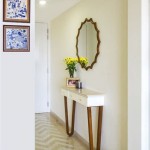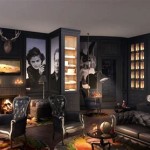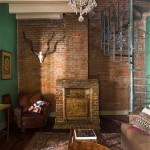Decorating with Shelves in the Living Room
Shelves offer versatile decorating solutions for living rooms, providing both functional storage and opportunities for stylish displays. They can contribute significantly to a room's aesthetic, introducing personality and visual interest. Properly utilized, shelves can transform a blank wall into a captivating focal point. This article explores different shelf types, styling strategies, and practical considerations for incorporating shelves into living room design.
Types of Shelves: The market offers a wide variety of shelving options, each with distinct aesthetic qualities and functional capabilities. Floating shelves, characterized by concealed hardware, create a clean, minimalist look. They are ideal for showcasing decorative objects and smaller items. Built-in shelves, often integrated into wall recesses or surrounding fireplaces, offer a more permanent and substantial storage solution. Ladder shelves, with their ascending design, provide a unique, space-saving display area. Corner shelves maximize space utilization in smaller living rooms, while bookcase-style shelves offer ample space for books and larger items.
Styling Shelves: The arrangement of items on shelves significantly impacts the overall aesthetic. A curated approach is essential to creating visually appealing and balanced displays. Consider incorporating a variety of objects such as books, plants, framed photos, decorative boxes, and sculptures. Varying the height and size of these items adds visual interest and prevents a monotonous look.
The Rule of Thirds: Applying the rule of thirds, a principle of design, can enhance the visual balance of shelf arrangements. This involves visually dividing the shelf space into thirds both horizontally and vertically. Placing key objects at the intersection of these lines creates a sense of equilibrium and draws the eye to these focal points.
Color Coordination: The color palette of items placed on shelves should complement the existing room decor. Repeating accent colors from the room's overall design creates a cohesive and harmonious look. Alternatively, using the shelves to introduce a contrasting color can add a vibrant pop of personality to the space.
Creating Visual Depth: Layering items on shelves creates a sense of depth and dimension. Placing smaller objects in front of larger ones or utilizing decorative trays to group items together adds visual interest and prevents a flat, two-dimensional appearance. Incorporating mirrors on the shelves can also amplify light and create an illusion of spaciousness.
Incorporating Greenery: Adding plants to shelves introduces a touch of nature and vibrancy to the living room. Trailing plants can soften the lines of the shelves, while smaller potted plants add pops of color and texture. Consider the lighting conditions of the room and choose plants that thrive in the available light.
Practical Considerations: Before installing shelves, assess the wall space and the intended use. Measure the available area carefully and consider the weight-bearing capacity of the wall. Ensure that the chosen shelves are appropriate for the intended load. For heavier items, opt for sturdy, wall-mounted shelves with adequate support.
Placement and Functionality: Consider the functionality of the shelves when determining their placement. Shelves intended for displaying decorative items can be placed higher on the wall, while those intended for storing frequently used items should be within easy reach. Avoid overcrowding shelves, as this can create a cluttered and disorganized appearance.
Maintenance: Regularly dusting and cleaning shelves helps maintain their appearance and prevents dust buildup. Consider the material of the shelves when choosing cleaning products to avoid damage. Wood shelves may require occasional polishing or waxing to maintain their luster.
Lighting: Integrating lighting into shelving displays can significantly enhance their visual impact. Small LED lights placed behind or under shelves create a warm, ambient glow and highlight displayed items. Consider installing dimmer switches to adjust the lighting intensity and create different moods.
Shelves as Room Dividers: In open-plan living areas, shelves can serve as effective room dividers. Open shelving units can delineate different zones within the space while maintaining a sense of openness and flow. This allows for visual separation between living and dining areas or other functional zones within the room.
Styling Bookshelves: Bookshelves offer a unique opportunity to showcase personal interests and collections. Arrange books by color, size, or genre to create a visually appealing display. Intersperse decorative objects among the books to add personality and prevent a monotonous look. Utilize bookends to keep books upright and add a touch of decorative flair.
Integrating Shelves with Existing Decor: When incorporating shelves into an existing living room design, consider the overall style and aesthetic of the space. Choose shelves that complement the existing furniture and decor. The color, material, and style of the shelves should harmonize with the room's overall design scheme.

Shelf Styling Inspiration Decor Living Room Shelves House Interior

680 Decorating Shelves Ideas Home Decor

How To Style Open Shelves 3 Tips For An Uncluttered Look House By Hoff

Bookcase Styling Essential Pieces For A New Look Jenny Reimold Shelf Decor Living Room Decorating Bookshelves Home

How To Decorate Shelves In 5 Easy Steps Abby Organizes

Four Easy Tips For Decorating Built In Shelves Our Hammock House

Where I Source Affordable Shelf Decor How To Style Built Ins Kate Knowles Home

310 Shelf Decor Ideas In 2025 Home

Four Easy Tips For Decorating Built In Shelves Our Hammock House

23 Best Living Room Wall Shelves Ideas Decor







